Test drive Porsche 911 Carrera S 997 since 2008 coupe
Compulsive test: Jaguar XKR, Porsche 911 Carrera S, Aston Martin V8 Vantage Roadster
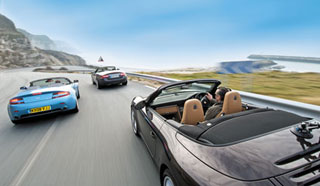 Open Jaguar XKR Convertible, Porsche 911 Carrera S Cabriolet and Aston Martin V8 Vantage Roadster defend the honor of their brothers in the summer season and fight for the title of best sports tap
Open Jaguar XKR Convertible, Porsche 911 Carrera S Cabriolet and Aston Martin V8 Vantage Roadster defend the honor of their brothers in the summer season and fight for the title of best sports tap The machine returned my credit card and raised the barrier, releasing me onto the paid highway. On the right, two more convertibles, like rope stallions, synchronously leave neighboring stalls, and their drivers give full gas. I am happy to follow their example. They rushed!
The roofs of all three cars are removed, and nothing prevents us from enjoying the orchestra of their engines, although one of them immediately and publicly declares his ambitions of the soloist. Jaguar compressor's juicy rocker and a metal roar of the Porsche Opposite Six are drowning in an atmospheric V8 atmospheric on Aston Martin. However, the most loud voice does not guarantee victory. The closer we get to the maximum permissible speed on the roads of France, the more obvious that our improvised race turns into a duel Porsche and Jaguar. As a result, I write down the victory on my account. More precisely, at the expense of his Jaguar XKR, which immediately struck us with the ability to go into a gap and disappear from sight as soon as the road becomes a straight line. Let's see what he is capable of in corners.
In the latest Jaguar models, more than ever, power is felt, and the point here is not only in the absolutely new 5-liter V8 motor, which, thanks to the compressor, gives out 510 hp. Keeping his traditional advantages, a wild cat boldly and confidently challenges cars with a much more sports reputation. In this case, this is the 385-horsepower Porsche 911 Carrera S Cabriolet and the 426-horsepower Aston Martin V8 Vantage Roadster.
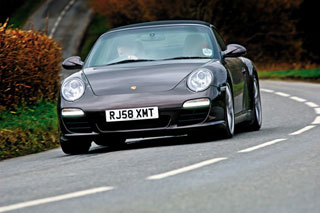 Geographical discovery
Geographical discovery Going on the road, our photographer did not think for long which car to choose to transport his equipment. Oddly enough, the smallest of them is best adapted for this - Porsche. In terms of trunk, it is not inferior to Aston, but in terms of convenience exceeds a much larger Jaguar. In addition, as in the XKR, there are two children's rear seats that can be used to accommodate things. Looking at this, it remains only to admire the German miracles of the layout and guess, where the entire volume of the body in two British went.
However, it was not as pleasant to go on the 911th as loading his luggles. At main speeds, its soft roof rustles in the wind, and the low -frequency rumble of the motor prevents the passenger from talking calmly. Aston is better in this regard, but the most comfortable colleagues and I unanimously recognized Jaguar, and even with the cleaned roof XKR practically does not lose its comfort.
After the 911th and Vantage, this car seems huge not only from the outside. In Porsche and Aston, you fall into low seats-shoes, and Jaguar meets you with massive seats, which, however, also perfectly fit your body thanks to adjustable rollers of lateral support. The XKR salon is trimmed with wood, and not more fashionable aluminum, but even in such a slightly old -fashioned Jaguar interior looks the most solid and high -quality in our trio. In addition, Jaguar, unlike Porsche, does not ask for separate money, for example, for decoration of the front panel of the skin and should not be a bad example of Aston Martin, in the stylish salon of which cheap buttons and steering wheel switches and glass cleaners spoil the impression.
Due to its size, Jaguar, even from the side, seems to be the most clumsy in this trio, and these suspicions are justified at the wheel. XKR cannot boast of such direct contact between the driver and the car as today's competitors. This is partly due to the operation of the hydrotransformer of the 6-band ZF machine, which dulls the reactions to the accelerator at low speeds. The steering wheel amplifier with a performance, depending on speed by performance, also makes its contribution: in most situations, the steering wheel is easier than we would like. After the assurances of Jaguar, that the XKR convertible in nature is practically no different from the compartment of the same name, all this is a little disappointed. But with the smoothness of the course, complete order.
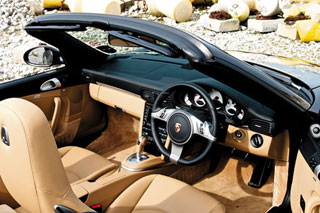 The difference in the characters between Porsche and Aston is much less. The 911th captivates from the very first meters: PASM adaptive shock absorbers (are included in the standard Carrera S complex) tightly, but without fuss they work out the irregularities of asphalt, the reference force on the steering wheel guarantees reliable feedback with the front wheels, and the brakes are grasped from the very beginning of the pedal and the pedal and the pedal and the pedal and the pedal allow you to accurately dose slowdown. In Porsche, the quality is not exhausted by the materials of the interior decoration and the convenience of buttons on the central console, it goes into the engineering depths of all components and assemblies. The PDK semiautomatic device with two clutches works with dignity, but we would prefer the 911st with the manual transmission - including because by car with PDK the algorithm of the work of the transmission of gears on the steering wheel (from itself - up, to ourselves - down) irritates its unnaturalness .
The difference in the characters between Porsche and Aston is much less. The 911th captivates from the very first meters: PASM adaptive shock absorbers (are included in the standard Carrera S complex) tightly, but without fuss they work out the irregularities of asphalt, the reference force on the steering wheel guarantees reliable feedback with the front wheels, and the brakes are grasped from the very beginning of the pedal and the pedal and the pedal and the pedal and the pedal allow you to accurately dose slowdown. In Porsche, the quality is not exhausted by the materials of the interior decoration and the convenience of buttons on the central console, it goes into the engineering depths of all components and assemblies. The PDK semiautomatic device with two clutches works with dignity, but we would prefer the 911st with the manual transmission - including because by car with PDK the algorithm of the work of the transmission of gears on the steering wheel (from itself - up, to ourselves - down) irritates its unnaturalness . The fact that the days of the mechanical KP are by no means uncleaning, convincingly resembles the V8 Vantage. It is difficult to describe the pleasure that you test by wielding a weighty and clear lever of the 6-speed Graziano box. The impression is slightly spoiled by the slurred moment of grasping the clutch. Aston’s steering wheel is harder than in Porsche, but this feature fits into a more courageous, even brutal image of a British car, and V8 Vantage suspension in general copes well with the flaws of the road surface, but does not always digest gross transverse cracks or asphalt joints.
Thanks to the classic cloth roofs, our cars are not burdened with overweight and layout problems that are characteristic of the Cabiolets with a folding hard top. In the open version, Aston and Jaguar completely hide the roof under the decorative casing, and Porsche leaves a small part of the fabric outside. Perhaps this is one of the secrets of the lightness of the 911st. Although both British have aluminum bodies, the steel porsche is noticeably easier: with a mass of 1510 kg, it wins 200 kg of V8 Vantage, and the XKR has almost 300 kg.
All three convertibles are equipped with deflector lattices, which are installed behind the seats and suppress twists in the cabin. The highest level of aerodynamic comfort is provided by Jaguar: at a speed of 130 km/h, the run -up air flow only slightly swaying the hair, and the heating of the seats and the climatic installation, the warm air from which the salon is enveloped, will not allow to freeze in an open car even in cold weather.
We keep a course on the Normandy coast and, leaving boring highways behind, we find ourselves on more interesting rural highways. On XKR, an active differential of increased friction finally manifests itself. The new 5-liter V8 gives out tremendous traction on the bottoms, but with the help of differential, the rear wheels digest it without problems.
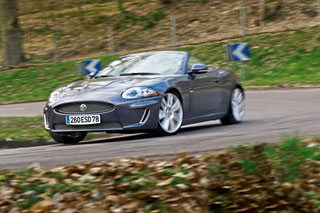 The 911th, due to its rear-engine layout, also does not suffer from a clutch clutch under the thrust, but a combination of a low mass and a gambling 385-horsepower engine (only four years ago even an extreme 911 GT3 generation 996 was 5 hp. Go a nostril to a nostril with a more powerful Jaguar. Aston also confidently clings to dry asphalt at acceleration, however, its 4.7-liter motor at low speeds pulls worse than that of competitors, and spreads the wings only to 5000 rpm, when the direct-flow valve in the final system opens.
The 911th, due to its rear-engine layout, also does not suffer from a clutch clutch under the thrust, but a combination of a low mass and a gambling 385-horsepower engine (only four years ago even an extreme 911 GT3 generation 996 was 5 hp. Go a nostril to a nostril with a more powerful Jaguar. Aston also confidently clings to dry asphalt at acceleration, however, its 4.7-liter motor at low speeds pulls worse than that of competitors, and spreads the wings only to 5000 rpm, when the direct-flow valve in the final system opens. In the distance, the sea is already visible, we lose speed to admire the opening views, and make a small discovery: limestone cliffs here are the same as on the southern coast of England, which means that the mainland and the island were once a single whole. But why is there a blue water in the sea, and in the Duvra is brown on the other side?
Triathlon
While our photographer is dealing with equipment, we study the appearance of cars. Aston looks irresistible. The loss of the roof only emphasized its squat silhouette. It is not surprising that it is the V8 Vantage that attracts the most attention of the public, although not only the design, but also the blue color of the body, as well as the piercing roar of the motor, make its contribution to this. Brown metallic, in which the 911th is painted, is called Macadamia, but the beautiful name does not make the car herself beautifully. Color is not the only aesthetic problem Porsche. In front, it can be mistaken for a cheaper Boxster, and on the side it looks awkward and thick -sized. For Jaguar, the transformation from the compartment into a convertible also did not pass without consequences: the car deprived of the flowing line of the roof looks rustic. Nevertheless, none of the cars suffers from convertible diseases, since all of them were originally developed with open bodies, in parallel with the compartment of the same name. The weight gain in comparison with closed versions is moderate 50-90 kg, and intra-axial rear-view mirrors practically do not tremble on irregularities, which indicates high stiffness of the bodies.
Not far from the coast, we find a highway section, blocked from one end due to road works. The photographer sat in one of the turns, and under the sight of his lens, we ride back and forth to Porsche and Jaguar. We had to leave Aston in the end, since its loud motor can angry local residents who will not fail to call the police.
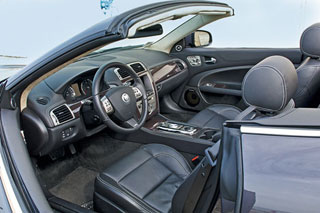 My colleague Roger sprinkles XKR and under the roar of the quartet of exhaust pipes disappears from sight. It’s not to catch up with the straight lines, but the road is narrow and winding, and this plays Porsche's hands. Soon we find a bunch of turns that will help to study the dynamics and handling of convertibles. At first, the road under a small slope goes down, to a well -viewed turn by almost 180. Its radius increases to the exit, and behind it follows a protracted right turn with a very late apex on the rise.
My colleague Roger sprinkles XKR and under the roar of the quartet of exhaust pipes disappears from sight. It’s not to catch up with the straight lines, but the road is narrow and winding, and this plays Porsche's hands. Soon we find a bunch of turns that will help to study the dynamics and handling of convertibles. At first, the road under a small slope goes down, to a well -viewed turn by almost 180. Its radius increases to the exit, and behind it follows a protracted right turn with a very late apex on the rise. I have to squeeze all the juices from the opponent of Porsche to keep up with Roger, who with juicy infusions besieges XKR before slow turns. The losing on the lines of the 911th makes up on braking and at the entrance to the turns, but the star hour Porsche occurs in a long turn.
The impenetrable grip of the rear wheels in the 911th is perceived as a granted one, but Carrera S perfectly keeps the road and the front axle. Although most of the mass of the car is concentrated from behind, the light nose does not try to slide out the turn in an fit of insufficient rotation. Having disconnected the PSM stabilization system, I enter the turn and sharply add the gas, directing the car to the apex. In the II transmission, the rear wheels receive a large torque, but the front are walking like along the rails and stubbornly cling to asphalt. From the entrance to the turn to the exit of it, the 911th plays three buildings from the XKR, and, having changed places with Roger, I understand why this is happening.
The XKR holds the trajectory at the entrance to the turn, and its suspension suppresses the cranes of the body worse. Although this is perhaps the best sports jaguar over the past decades, after Porsche you feel a little distant from the road here, and in the reactions of the car to the driver’s actions there is no clarity that the 911th differs. The rotation of the round selector of the machine from the Drive position to Sport accelerates the gear shift, but the light steering wheel does not allow you to accurately set the attack angle, and the brakes sometimes make their work too zealously. To smooth out the picture, you need to act as restrained and accurately as possible. The only exception to this rule is the gas pedal, which can be safely crushed to the stop, using a magnificent clutch under the thrust. If you completely disconnect the DSC stabilization system, the car does not lose its grip, but you should not demand the impossible from the rear wheels. The appearance of the stern must be anticipated by listening to the behavior of the machine, since it develops rapidly.
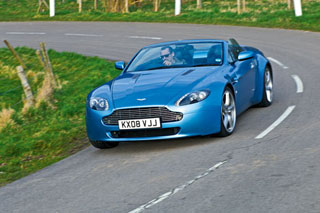 Aston is more like habits to the 911th. The steering and suspension are very informative, the reactions of the machine are reliable and accurate, and the flaws of the road surface do not remove the chassis from balance. The collected and obedient character of the V8 Vantage allows us to confidently study the limits of the capabilities of this car, sitting in a strong arms of a sports chair.
Aston is more like habits to the 911th. The steering and suspension are very informative, the reactions of the machine are reliable and accurate, and the flaws of the road surface do not remove the chassis from balance. The collected and obedient character of the V8 Vantage allows us to confidently study the limits of the capabilities of this car, sitting in a strong arms of a sports chair. And yet, despite the exact steering wheel and good coating, Aston does not have such a self -control as Porsche. So, in protracted turns with strong side overloads, shock absorbers sometimes lack hardness. But in general, the controllability of this convertible is quite consistent with its dynamic potential. Only now the sound of the motor spreading per kilometers around is not always appropriate.
On wider and wider and straight roads, Jaguar allows you to maintain the highest pace, but as soon as the highway becomes more winding, XKR again feels at ease again. Where Porsche and Aston find themselves in the native elements, Jaguar begins to indistinctly respond to the driver’s actions, which is especially noticeable with hard braking, when the whole car walks a little.
As a convertible, comfortable and noble XKR is magnificent, and in relatively simple road conditions it easily manages to keep the highest speed. But with all his advantages, he still remains a Gran Turismo class, not a sports car. A direct competitor of the XKR could be already withdrawn from the production of Mercedes SL 55 AMG - the same fast and emphasized comfortable. And the V8 Vantage and the 911th on the imaginary sports scale is much closer to clean sport than the XKR.
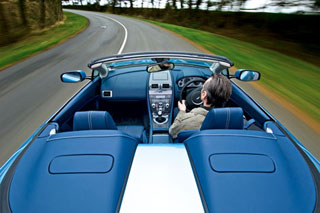 In the confrontation of Porsche and Aston, everything is much more complicated. From the point of view of the pragmatist V8 Vantage is a losing option. It is less practical, much more voracious and is slightly inferior to 911th in speed. But pragmatists do not buy such cars, and the Aston Martin style makes you close your eyes to all its shortcomings.
In the confrontation of Porsche and Aston, everything is much more complicated. From the point of view of the pragmatist V8 Vantage is a losing option. It is less practical, much more voracious and is slightly inferior to 911th in speed. But pragmatists do not buy such cars, and the Aston Martin style makes you close your eyes to all its shortcomings. 911 Cabriolet is noteworthy primarily because it is not inferior in practicality and running qualities. We would not order this car in brown color, although no matter what color it is, Cabriolet was and remains the most unsympathetic body version of the 911st.
But controversial aesthetics are not able to hide the fact that as a car for a 911 driver in this trio out of competition. At the wheel of Aston you also do not get bored, but his habits are not so impeccable. On dry asphalt, the V8 Vantage is practically competing on Porsche on equal terms, but in the rain it turns into an unbridled beast even with the stabilization system turned on. If you want to have fun while driving a convertible, 911 Convertible will live up to your expectations. But in the V8 Vantage Roadster, this pleasure does not end at the wheel.
Technical characteristics Porsche 911 Carrera S Cabriolet
Dimensions, mm
no data
Equipped mass, kg
1510
engine's type
basin 6-cylinder opposition
Working volume, cubic meter. cm
3800
Max. Power, L.S./rpm
385/6500
Max. moment, nm/rpm
426/4400
Transmission
robotic? -Diapasic with two clutches
Drive unit
rear
Max. speed, km/h
302
Acceleration time 097 km/h, with
4,9
Fuel consumption (average), l/100 km
no data
Technical characteristics Jaguar XKR Convertible
Dimensions, mm
no data
Equipped mass, kg
1800
engine's type
v8 gasoline with a supercharger
Working volume, cubic meter. cm
5000
Max. Power, L.S./rpm
510/6000
Max. moment, nm/rpm
625/2500-5500
Transmission
automatic 6-band
Drive unit
rear
Max. speed, km/h
250*
Acceleration time 097 km/h, with
4,8
Fuel consumption (average), l/100 km
no data
Technical characteristics Aston Martin V8 Vantage Roadster
Dimensions, mm
no data
Equipped mass, kg
1700
engine's type
gasoline V8
Working volume, cubic meter. cm
4735
Max. Power, L.S./rpm
426/7000
Max. moment, nm/rpm
470/5750
Transmission
mechanical 6-Steppendered
Drive unit
rear
Max. speed, km/h
290
Acceleration time 097 km/h, with
4,9
Fuel consumption (average), l/100 km
no data
* With an ethletron limiter
John Barker
Stuart Collins
Evo publications ltd
Source: Avtopanorama magazine





